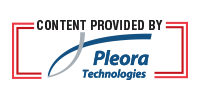
Dairy Distillery, a Canadian spirits manufacturer that has pioneered a unique process to produce vodka from a dairy byproduct, uses AI visual inspection to add decision-support for manual labelling and quality control (QC) checks.
Brand appearance plays a significant role in consumer choice, and the manufacturer competes against larger players with much deeper marketing budgets. The distillery uses a bottle fashioned after an old fashioned milk bottle, with distinctive and eye-catching labelling. The main label and a cap label are applied by machine. A human has to accurately place an emblem logo that visually aligns with brand elements on the other labels to ensure a consistent and appealing shelf display. With multiple products and short manufacturing runs, it’s uneconomical for the distillery to fully automate its labelling process.
Over a long shift, the emblem placement would begin to shift as the operator got tired. Mistakes were often not noticed until the final packaging stage, when staff were then tasked with manually removing and replacing labels. This resulted in downtime, production delays, and additional costs. Worse, there was always the risk a poorly labelled product could reach the store shelves.
AI-based visual inspection provides decision-support for the operator to help eliminate labelling errors. The system includes a camera, edge processing, display panel, and pre-packaged AI plug-ins from common inspection requirements. Pre-packaged inspection skills are easily trained to verify components, inspect labelling, and check assembly, or customized for specific requirements.
As a fully integrated tabletop system, the operator uses the camera and edge processing to acquire images and create an AI model. They don’t need to switch between cameras, PCs, or cloud-based systems; making the system easy-to-use, highly cost-effective, and all in a smaller footprint.
Without requiring any programming skills, the distillery quality manager and operator trained the image compare plug-in to add decision-support for its labelling process. With just one image of a known good product – a “golden reference” – the system automatically identifies the key brand elements on the bottle. The plug-in has been customized to then add a graphic overlay on the visual display that highlights and guides the correct placement of the medallion label for the operator.
AI-based visual inspection ensures brand consistency and accuracy for the distillery, as well as cost-savings as labelling does not have to removed and replaced due to human error. The technology is also being used by the manufacturer as a training tool for new operators, so they can quickly understand the proper positioning of brand elements on the bottle and the difference between “good and bad” products.
With expanding production, the quality manager or operator can easily update the visual inspection system with additional “golden references” to provide labelling guidance for new bottles, labelling, and packaging. The operator simply chooses the correct plug-in for the product to be inspected. An additional image save plug-in could also be used to capture images of products at various stages of production for batch tracking. This will also provide the manufacturer with key data related to their manual assembly and inspection processes for root cause analysis and productivity management.
As the distillery adds more automation to its production, the visual inspection system can provide a valuable QC check for in-process or finished goods to ensure all machines and humans are operating in sync. With this approach, the operator is using the AI system to inspect a number of bottles in various stages of production to ensure brand accuracy. This helps remove stressful subjective decision-making for operators, and will increase production as errors can be identified well before final packaging.
Changing Visual Inspection
Adding decision support and automating processes for visual inspection helps ensure consistency. The technology aids a tired operator at the end of a shift, a new employee who is unsure what makes a product “good” or “bad”, or simply speed the inspection process. It lets manufacturers take advantage of new technologies for processes where automation is cost prohibitive, including production of lower volume, higher value goods.
